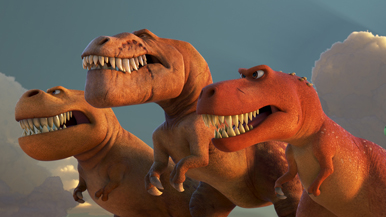|
|
Movie Review: The Good DinosaurBy Ben GruchowDecember 2, 2015
There are moments where we are on the verge of emotional discovery or catharsis - a big part of the character journey involves the quintessential Disney absence of parental figures, usually through the death of one or both of them—only to retreat into safer, tamer space. And there’s a long stretch of the film involving tyrannosaurs as buffalo herders (yes, you read that right) that seems to have bumbled in from a different, lesser animated film; it’s bright and cheerful, and the lead tyrannosaur is voiced by Sam Elliott with conviction if not persuasion, but it doesn’t fit at all with the surrounding world and incident. They don’t really amount to anything; once their screen time has elapsed, we pick up more or less where we left off (absent some antagonists that feel distinctly like a plot device). We shouldn’t mark off a Pixar film for having a simple, easily-digestible storyline once in a while, but we’ve every inkling of history to expect smarter, fleeter construction of that storyline than what we see here. And yet, every time I start to think that the movie’s flubs at the level of basic storytelling are really a problem, the space for complaining ends up being occupied by something the movie does right: the simple and elegant visualization of family, or the malevolent near-sentience of a flooding river, or the subtleties of the character’s facial expressions. Or I can just sit back and think about the sheer detail and scope of the movie’s settings. The movie’s sense of reality is extraordinarily persuasive. The character designs take some getting used to, and I was initially irritated by the juxtaposition of the rounded-off, cartoony characters populating a photorealistic world—but the look of it won me over fairly quickly. There aren’t many animated films that would take this kind of visual risk, and it’s paid off here. Where does The Good Dinosaur sit in the Pixar lexicon? I think it’s fair to consider it as a product of its original time, and how it would have perhaps been received last year or in 2013. Considered as a 2015 release, it throws well under last summer’s Inside Out for inventiveness and depth of feeling. It should be fairly clear at this point, though, that Inside Out is the exception instead of the rule, even within the context of Pixar’s generally high level of quality. It would be enormously unfair to expect every project to hit that lofty of a target. This one deserves to rank ahead of Monsters University, Cars and its sequel, and just behind A Bug’s Life. The movie whiffs on substantive storytelling and characters, but I still find it passing the litmus test that no Pixar film has yet really failed: how egregious its flaws are when considered independently of the Pixar label, or against a non-Pixar CGI animated film. I just wish I didn’t have to keep reminding myself of that while watching it.
|

|
|
|

|
Thursday, October 31, 2024
© 2024 Box Office Prophets, a division of One Of Us, Inc.


